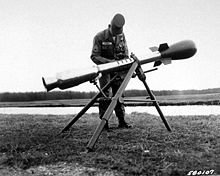Davy Crockett (nuclear weapon)
The Davy Crockett (referred to as M28 or M29 depending on the caliber ) was a tactical nuclear weapon of the United States , which was developed by the US Army during the Cold War in the 1950s and then stationed in Germany. It was the smallest nuclear weapon ever built and fired an atomic warhead with the designation M-388 and a selectable explosive force of 10 or 20 tons of TNT equivalent . It was fired from a gun carriage based on the principle of a recoilless gun , with ranges between 2 and 4 km being achieved. The name refers to the American congressman, soldier and folk hero Davy Crockett (1786-1836).
Production and deployment
Production of the Davy Crockett began in 1956. A total of 400 warheads were manufactured. From 1961 to 1971 the weapon was in various locations of the US Army, and was also stationed in Germany. After that it was surpassed and replaced by nuclear explosive devices for the 155-millimeter M109 howitzers .
As part of the " Little Feller I " atomic test, a downing of the Davy Crockett with ignition of the nuclear explosive was tested on July 17, 1962 . This was the last surface test of a nuclear weapon on the Nevada Test Site .
Properties and type of use

The Davy Crockett was built during the Cold War in the calibers 120 millimeters (M-28) and 155 millimeters (M-29) and had a range of two (M-28) to four kilometers (M-29). The Mk-54 nuclear missile explosive device of the M-388 projectile weighed around 23 kilograms and had an explosive force of 10 or 20 tons of TNT, adjustable in two stages . The weapon was intended for a battlefield use of the US infantry against troops of the Warsaw Pact in Germany . For this, the 7th US Army in southern Germany was equipped with Davy Crockett on a trial basis . However, the introduction at battalion level made many US commanders uncomfortable because, after the general approval by the US President, American NCOs would have been armed with nuclear weapons. After their introduction in 1961, these tactical nuclear weapons were withdrawn from Germany in 1965.
Problem
Some military and politicians did not recognize the danger of starting a nuclear war when using the Davy Crockett . In the mirror -Article Due ready for defense , the Spiegel affair triggered in 1962, describes how Franz Josef Strauss the lack of soldiers towards the Soviet Union by the Davy Crockett wanted to compensate. The United States has never relinquished control of its nuclear weapons and their use - even for the nuclear participation of NATO partners.
It has been discussed on various occasions that, depending on the exact setting of the firing range and explosive power, the shooting team would have been contaminated by their own Davy Crockett , since the radius of the fatal or at least severe radiation could be greater than the minimum firing range.
Web links
- nuclear-weapons.info/vw.htm#Wee%20Gwen (English)
- Video of the M-388 Davy Crockett Nuclear Test (English)
- Operation Ivy Flats. Government film from 1962 on YouTube
Individual evidence
- ↑ a b withdrawal from Europe . In: Der Spiegel . No. 24 , 1965 ( online ).
- ↑ Nuclearweaponarchive.org Accessed on March 6th, 2016
- ↑ a b Conditionally ready for defense . In: Der Spiegel . No. 41 , 1962 ( online ).
- ↑ Nuclearweaponarchive.org Retrieved on 4 October 2016
- ^ D. Carter: War Games in Europe . In: J. Hoffenaar, D. Krüger (Ed.): Blueprints for Battle. Planning for War in Central Europe, 1948–1968 . Kentucky 2012, pp. 131–153, here p. 148 f.
- ↑ DavyCrockett . ( Memento from October 27, 2006 in the Internet Archive ) In: guntruck.com (English)

